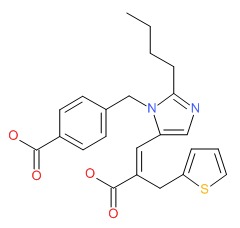NCBI Bookshelf. A service of the National Library of Medicine, National Institutes of Health.
LiverTox: Clinical and Research Information on Drug-Induced Liver Injury [Internet]. Bethesda (MD): National Institute of Diabetes and Digestive and Kidney Diseases; 2012-.

LiverTox: Clinical and Research Information on Drug-Induced Liver Injury [Internet].
Show detailsOVERVIEW
Introduction
Eprosartan is an angiotensin II receptor blocker used in the therapy of hypertension. Eprosartan is associated with a low rate of transient serum aminotransferase elevations but has yet to be linked to instances of acute liver injury.
Background
Eprosartan (ep" roe sar' tan) is an angiotensin II receptor blocker (ARB) used alone or in combination with other agents for therapy of hypertension. Eprosartan inhibits the renin-angiotensin system by blocking the angiotensin II type 1 receptor (AT1), which prevents the vasoconstriction and volume expansion induced by circulating angiotensin II thus accounting for its antihypertensive activity. Eprosartan was approved for use in the United States in 1997 for the treatment of hypertension. Eprosartan is available in 400 and 600 mg tablets generically and under the trade name Teveten. The typical dose in adults in 400 to 800 mg daily in one or two divided doses, and it is used long term. Eprosartan is also available in fixed combinations with hydrochlorothiazide (Teveten HCT). Side effects are uncommon, but can include headache, dizziness, fatigue, edema, cough, gastrointestinal upset, and fetal toxicity. Many ARBs including eprosartan have been linked to rare instances of a severe sprue-like enteropathy that presents with chronic diarrhea and weight loss and villous flattening and atrophy on intestinal biopsy. The diarrhea usually arises after 6 months or more of therapy and does not respond to corticosteroids or a gluten-free diet, but does resolve promptly with stopping eprosartan. This adverse side effect is most common wtih olmesartan.
Hepatotoxicity
Eprosartan has been associated with a low rate of serum aminotransferase elevations (<2%) that in controlled trials was no higher than with placebo therapy. These elevations were transient and rarely required dose modification. No specific instances of clinically apparent acute liver injury have been reported in association with eprosartan therapy, but like other ARBs, it may be associated with rare instances of symptomatic hepatotoxicity. The typical onset of ARB-associated liver injury is within 1 to 8 weeks of starting therapy and the serum enzyme pattern is typically hepatocellular with an acute hepatitis-like clinical syndrome. In some instances, cholestasis has developed which can be prolonged and relapsing, but ARB therapy has not been associated with vanishing bile duct syndrome or chronic liver injury. Immunoallergic manifestations (rash, fever, eosinophilia) are not common, nor is autoantibody formation. In addition, some patients with ARB-related enteropathy also develop fatty liver and steatohepatitis which can be associated with serum aminotransferase elevations.
Likelihood score: E* (Unproved but suspected rare cause of clinically apparent liver injury).
Mechanism of Injury
The cause of the minor serum aminotransferase elevations with eprosartan is not known. Eprosartan is metabolized in the liver to a glucuronide which is excreted in the urine. Eprosartan does not appear to be metabolized by the cytochrome P450 system and has minimal drug-drug interactions.
Outcome and Management
The instances of acute liver injury reported with ARB use have been self limited and have not resulted in acute liver failure or chronic liver injury. While corticosteroids have been used in cases of severe cholestasis due to ARBs, their efficacy has not been shown and their use is best avoided. Patients with eprosartan induced liver injury should probably avoid use of other ARBs, although cross sensitivity to liver injury among the members of this class of agents has not been shown.
References on the safety and potential hepatotoxicity of eprosartan are given in the Overview section on the angiotensin II receptor antagonists.
Drug Class: Antihypertensive Agents, Angiotensin II Receptor Antagonists
Other Drugs in the Subclass, Angiotensin II Receptor Antagonists: Azilsartan, Candesartan, Irbesartan, Losartan, Olmesartan, Telmisartan, Valsartan
PRODUCT INFORMATION
REPRESENTATIVE TRADE NAMES
Eprosartan – Teveten®
DRUG CLASS
Angiotensin II Receptor Antagonists
Product labeling at DailyMed, National Library of Medicine, NIH
CHEMICAL FORMULA AND STRUCTURE
| DRUG | CAS REGISTRY NUMBER | MOLECULAR FORMULA | STRUCTURE |
|---|---|---|---|
| Eprosartan | 133040-01-4 | C23-H24-N2-O4-S |
 |
- PubChem SubstanceRelated PubChem Substances
- Review Potential of the angiotensin II receptor 1 blocker eprosartan in the management of patients with hypertension or heart failure.[Curr Hypertens Rep. 2001]Review Potential of the angiotensin II receptor 1 blocker eprosartan in the management of patients with hypertension or heart failure.Hollenberg NK. Curr Hypertens Rep. 2001 Sep; 3 Suppl 1:S25-8.
- Acute eprosartan-induced intrarenal vasodilation in hypertensive humans is not influenced by dietary sodium intake or angiotensin II co-infusion.[J Hypertens. 2016]Acute eprosartan-induced intrarenal vasodilation in hypertensive humans is not influenced by dietary sodium intake or angiotensin II co-infusion.van Twist DJ, Houben AJ, de Leeuw PW, Kroon AA. J Hypertens. 2016 Aug; 34(8):1607-14.
- Review Angiotensin II Receptor Antagonists.[LiverTox: Clinical and Researc...]Review Angiotensin II Receptor Antagonists.. LiverTox: Clinical and Research Information on Drug-Induced Liver Injury. 2012
- Review Eprosartan: a review of its use in hypertension.[Drugs. 2009]Review Eprosartan: a review of its use in hypertension.Plosker GL. Drugs. 2009; 69(17):2477-99.
- Review Olmesartan.[LiverTox: Clinical and Researc...]Review Olmesartan.. LiverTox: Clinical and Research Information on Drug-Induced Liver Injury. 2012
- Eprosartan - LiverToxEprosartan - LiverTox
Your browsing activity is empty.
Activity recording is turned off.
See more...